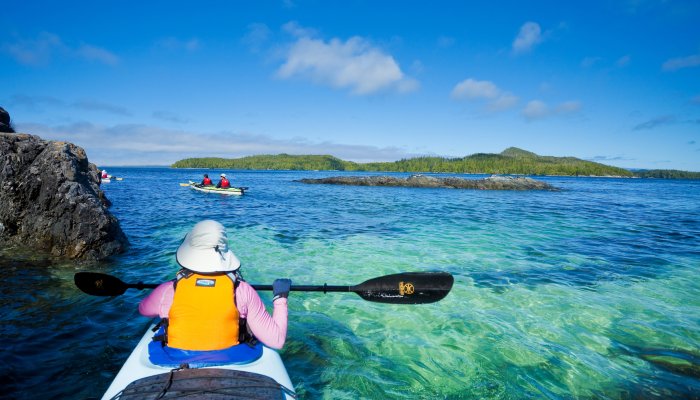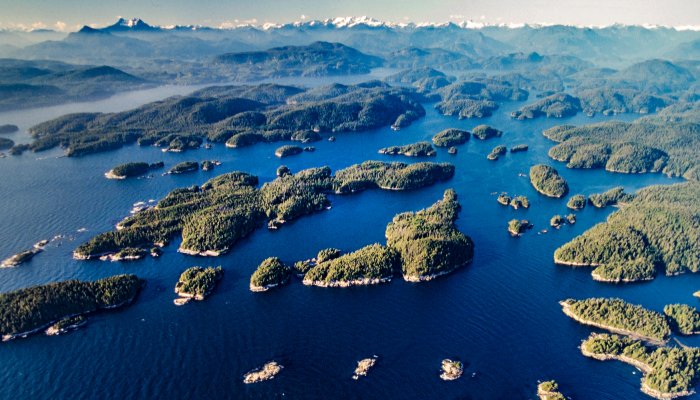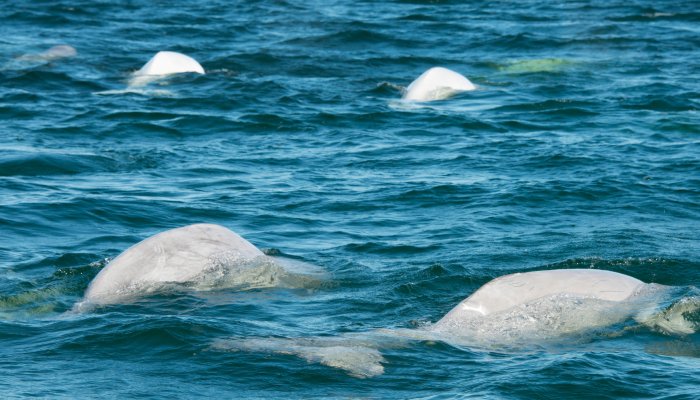Kayaking with orcas and meeting the majestic killer whale in its own environment inspires dreams among many admirers, and often a bit of awe for others. Orcas hold both the reputation of a ferocious predator as well as a glamorized, friendly “Seaworld” performer and everything in between. As many companies advertise orca kayaking tours with stunning photographs of close encounters, many people acquire the impression that they will spend hours each day kayaking with killer whales. Such expectations do not take into account the laws which protect the orcas, the behavior of these animals, and the geographic location of the kayak tour.
Since 1996, Sea Kayak Adventures has operated tours off of northern Vancouver Island in Johnstone Strait, the best orca location on Earth to observe a unique congregation of specifically fish-eating killer whales found only here. Every summer we guide hundreds of guests to kayak orca waters and return to Telegraph Cove with glowing faces, happy customers, and stories of whale magic. Here are some helpful tips and clarifications to assist in a better understanding of your experience:
Where is the best place to kayak with orcas? How often do you see orcas on a kayak trip? When is the best time to see the Orcas? How close can I get to an orca from a kayak? How does everyone get close-up photographs? How dangerous are these “killer whales?” What if I don’t get enough orca time on my kayak trip?
Where is the best place to kayak with orcas?This question requires a bit of background information. Orcas are found in every ocean on the planet. They are actually members of the dolphin (“toothed whale”) family and possess superb intelligence, which means that subgroups have adapted to surroundings that vary from frigid Antarctic waters to tropical environments. The Pacific Northwest of North America hosts several populations of “Resident” orcas that frequent the same areas consistently. Consequently, this area has become known for killer whale sightings and a tourism industry has built up around these marvelous marine mammals.
However, not all places in the Northwest are created equal when it comes to kayaking with killer whales. The San Juan Islands, famed for the orca presence, actually has the smallest population of Residents; just three pods totaling 89 whales swim the coastal waters of Oregon, Washington, and even up to British Columbia. This can mean disappointment for kayakers and whale watching tours, even if orcas are known to be in adjacent waters. The speed and range of killer whales in the open ocean means that hopeful guests have perhaps a 30% chance – at best – to see these whales while kayaking.
Consequently, Sea Kayak Adventures established our orca tours off of the northern part of Vancouver Island, near Johnstone Strait. Every summer the Northern Residents (over 200 orcas!) seek salmon in this small channel (just 68 miles long and a maximum of 3 miles wide) and the surrounding archipelago. The numbers alone dictate the greater chance of whale sighting success.
How often do you see orcas on a kayak trip?From mid-July through mid-September, our trips host 95% or better orca sightings in Johnstone Strait. You might not see them every day of your kayak trip, but with 4-6 days wandering through this pristine wilderness, your chances of seeing orcas by kayak, swimming by your campsite, or near the world’s only orca preserve are very, very good!
We also offer lodge-based trips at God’s Pocket Resort for those who prefer not to camp. While we occasionally see orcas on our God’s Pocket trips, this area is not in the heart of orca territory. You would be better suited to taking a day of whale watching before or after your God’s Pocket trip if you are determined to see orcas.
When is the best time to see the Orcas?
As mentioned, mid-July through mid-September is peak orca season. However, this is not a hard and fast rule as killer whales care little for our calendar; they follow the salmon. When the salmon are present, so are the orcas. If your calendar is restricted to early July or late June, the orcas are not as likely to be around. You will still have a chance to see wonderful singing humpback whales (an absolutely incredible experience that many people pay great money to see), porpoises, dolphins, sea lions, seals, sea stars, bald eagles, bear, moose, and many others that make Johnstone Strait a slice of heaven.
How close can I get to an orca from a kayak?Johnstone Strait follows the same Be Whale Wise regulations as all of British Columbia adheres to: no one is allowed to get within 100 yards/meters of an orca, and must reduce speed to less than 7 knots within 400 meters. Specific guidelines for paddlers may be found here. We are privileged to have the opportunity for viewing whales from these close vantage points. In the San Juan Islands, the limit is twice as far. Sea Kayak Adventures proudly upholds all Be Whale Wise regulations.
Companies that encourage illegal paddling to the orcas or promise closer encounters should be reported to Fisheries & Oceans Canada (1-800-465-4336) or NOAA Fisheries, Office for Law Enforcement (1-800-853-1964). The very survival of the species, let alone the wonder of seeing them in their natural habitat, depends on everyone’s cooperation in these regulations.
How does everyone get close-up photographs?A telephoto lens can certainly skew perspective and make an orca seem very close, but some photos are quite candid. As mentioned, orcas can travel MUCH faster than a kayak! Even when we follow Be Whale Wise regulations and paddle out of their way to the kelp bed, a pod of swiftly moving orcas can overtake a group of kayaks. Great photos have been captured when the orcas and swim past kayakers – they don’t always obey the law. Additionally, orcas regularly swim right by our campsites, which can make for a fantastic, close-up photo from the respectful boundary of the shore. Understanding the behavior and range of these marvelous creatures helps to better set your expectations for your orca kayak tour.
How dangerous are these “killer whales?”The orcas of Johnstone Strait have never bumped a kayak or attacked a swimmer. As mentioned, orcas roam the waters of every ocean on the planet. They have adapted into specialized subspecies that hunt the prey that their territories cover – everything from sea turtles to sharks. While many people think of orcas a seal-eaters, some orcas don’t even eat mammals. In fact, the “killer whales” of Johnstone Strait come solely to eat the salmon in this narrow channel and leave the other creatures alone.
What if I don’t get enough orca time on my kayak trip?For those who are hooked on killer whales and have extra time on Vancouver Island, we recommend a whale watching tour with our friends at Stubbs Island Whale Watching or Mackay Whale Watching tours. These experienced operators can take you by boat where orcas sightings are reported – a feat we would have trouble repeating with slow-moving kayaks.



